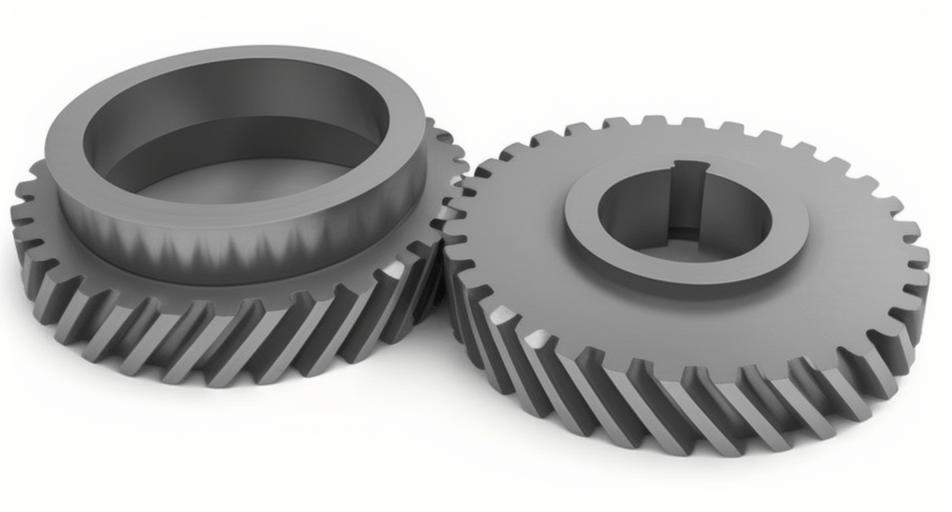
Helical gear play a pivotal role in modern automotive transmission systems due to their efficient power transmission capabilities and smooth operation. Their design, characterized by angled teeth, allows for gradual engagement and disengagement, which minimizes noise and vibration. This article explores the critical role of helical gear in automotive transmissions, discussing their benefits, applications, and advancements in technology.
Importance of Helical Gear in Automotive Transmissions
- Smooth Operation:
- Helical gear engage gradually due to their angled teeth, resulting in smooth power transmission with minimal vibration.
- This smooth operation is crucial for driver comfort and vehicle performance.
- High Load Capacity:
- The design of helical gear allows them to handle higher loads compared to spur gear.
- This capacity makes them suitable for high-torque applications in automotive transmissions.
- Efficiency:
- Helical gear has higher contact ratio, which means more teeth are in contact at any given time, leading to more efficient power transmission.
- This efficiency contributes to better fuel economy and performance in vehicles.
Applications of Helical Gear in Automotive Transmissions
- Manual Transmissions:
- Helical gear is used in manual transmissions to provide different gear ratios, allowing drivers to select the appropriate gear for various driving conditions.
- Their smooth operation enhances the shifting experience and reduces wear on transmission components.
- Automatic Transmissions:
- In automatic transmissions, helical gear is integral to the planetary gear sets, which provide multiple gear ratios without manual intervention.
- The high load capacity and efficiency of helical gear is essential for the complex gear arrangements in automatic transmissions.
- Dual-Clutch Transmissions (DCT):
- DCT systems use helical gear to enable quick and smooth gear shifts by pre-selecting the next gear.
- The reduced noise and vibration from helical gear improve the overall driving experience in high-performance vehicles.
- Continuously Variable Transmissions (CVT):
- While CVTs primarily use belts and pulleys, helical gear is employed in auxiliary components to ensure smooth and efficient power transmission.
- Their reliability and durability support the seamless operation of CVTs.
Advancements in Helical Gear Technology for Automotive Transmissions
- Material Innovations:
- Advanced materials such as high-strength steel alloys and composites are used to manufacture helical gear, enhancing their durability and performance.
- These materials reduce weight while maintaining or improving load capacity and wear resistance.
- Precision Manufacturing:
- Advanced manufacturing techniques, including CNC machining and additive manufacturing, enable the production of helical gear with high precision and tight tolerances.
- This precision improves the efficiency and reliability of automotive transmissions.
- Surface Treatments and Coatings:
- Surface treatments like carburizing, nitriding, and coatings such as Diamond-Like Carbon (DLC) are applied to enhance the wear resistance and longevity of helical gear.
- These treatments also reduce friction, contributing to smoother operation and better fuel efficiency.
- Noise Reduction Technologies:
- Innovations in helical gear design, such as optimized tooth profiles and damping materials, help reduce noise and vibration.
- These advancements are crucial for enhancing the comfort and overall driving experience.
Benefits of Helical Gear in Automotive Transmissions
- Improved Fuel Efficiency: The efficient power transmission of helical gear contributes to better fuel economy in vehicles.
- Enhanced Durability: Advanced materials and manufacturing techniques increase the lifespan of helical gear, reducing maintenance costs.
- Smooth Shifting: The gradual engagement of helical gear provides smooth and quiet gear shifts, improving driving comfort.
- High Performance: The ability to handle high loads makes helical gear suitable for high-performance and heavy-duty vehicles.
Case Study: Helical Gear in a Modern Automatic Transmission
Application: Automatic transmission in a mid-sized sedan.
Challenges: The transmission must provide smooth shifting, handle high torque, and ensure fuel efficiency.
Solution:
- Gear Design: Utilized helical gear with optimized tooth profiles for smoother engagement and reduced noise.
- Material Selection: Employed high-strength steel alloys with surface treatments to enhance wear resistance.
- Precision Manufacturing: Implemented advanced CNC machining to achieve high precision and tight tolerances.
- Noise Reduction: Applied damping materials in helical gear housing to minimize noise and vibration.
Results:
- Fuel Efficiency: Improved by 10% due to more efficient power transmission.
- Durability: Increased gear lifespan by 20%, reducing maintenance requirements.
- Driving Comfort: Enhanced due to smoother and quieter gear shifts.
- Performance: Maintained high torque handling capabilities, ensuring robust vehicle performance.
Table: Comparison of Gear Types in Automotive Transmissions
| Feature | Helical Gear | Spur Gear | Planetary Gear |
|---|---|---|---|
| Smooth Operation | High | Low | Moderate |
| Load Capacity | High | Moderate | High |
| Noise and Vibration | Low | High | Moderate |
| Efficiency | High | Moderate | High |
| Applications | Manual, Automatic, DCT, CVT | Manual, Simple Transmissions | Automatic, Hybrid Systems |
List: Key Considerations for Helical Gear Design in Automotive Transmissions
- Load Requirements: Assess the maximum torque and load conditions helical gear will need to handle.
- Material Selection: Choose materials that offer the best combination of strength, weight, and wear resistance.
- Manufacturing Precision: Ensure high precision in helical gear manufacturing to achieve tight tolerances and smooth operation.
- Surface Treatments: Apply appropriate surface treatments to enhance durability and reduce friction.
- Noise and Vibration Control: Incorporate design features and materials that minimize noise and vibration for improved driving comfort.
Conclusion
Helical gear is indispensable components in modern automotive transmission systems, offering a combination of smooth operation, high load capacity, and efficiency. Advances in materials, manufacturing techniques, and design have further enhanced the performance and reliability of helical gear, making them ideal for a wide range of automotive applications. By understanding and leveraging these advancements, automotive engineers can design transmission systems that meet the demands of today’s vehicles, providing drivers with improved performance, fuel efficiency, and comfort.
